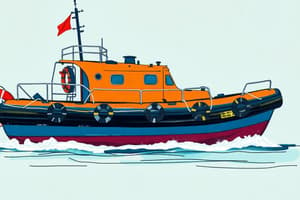Podcast
Questions and Answers
What is the primary obligation of those in command when deciding on operating speed?
What is the primary obligation of those in command when deciding on operating speed?
- To assess the appropriateness of the chosen speed and decision factors (correct)
- To maximize speed to ensure the quickest response
- To prioritize training over immediate service requirements
- To ensure compliance with maximum speed limits only
Under which circumstances can SAR assets operate above the normal speeds outlined?
Under which circumstances can SAR assets operate above the normal speeds outlined?
- If the weather conditions permit high speeds
- When the crew feels comfortable with increased speeds
- Only when there are life-threatening service calls or specific training requirements (correct)
- During all service calls without restrictions
What should be included in all briefings according to the guidance?
What should be included in all briefings according to the guidance?
- Detailed reports of past operations
- The rationales for decisions made about speed (correct)
- A list of all crew members present
- Personal experiences of the crew regarding speed management
What does 'safe speed' refer to in this context?
What does 'safe speed' refer to in this context?
Why is due diligence important when deciding to operate at higher speeds?
Why is due diligence important when deciding to operate at higher speeds?
What is the primary purpose of the guidance note regarding cruising speed for lifeboats?
What is the primary purpose of the guidance note regarding cruising speed for lifeboats?
Which principle is emphasized in the guidance to ensure safety during operations?
Which principle is emphasized in the guidance to ensure safety during operations?
Who is the guidance owner of the Safe Use of Speed Guidance?
Who is the guidance owner of the Safe Use of Speed Guidance?
What must the chosen transit speed consider according to the guidance?
What must the chosen transit speed consider according to the guidance?
What significant events led to the establishment of this guidance on maximum speed?
What significant events led to the establishment of this guidance on maximum speed?
Which rule is referenced in relation to operating at safe speeds in the guidance?
Which rule is referenced in relation to operating at safe speeds in the guidance?
Who should take responsibility for decision-making regarding vessel speed during operations?
Who should take responsibility for decision-making regarding vessel speed during operations?
What stance does the guidance suggest the institution should adopt regarding operating speeds?
What stance does the guidance suggest the institution should adopt regarding operating speeds?
Which vessel has the highest maximum speed?
Which vessel has the highest maximum speed?
What is the maximum speed of the Mersey?
What is the maximum speed of the Mersey?
Which vessel operates at a maximum speed of 18.5 Knots?
Which vessel operates at a maximum speed of 18.5 Knots?
Which of the following has a maximum speed of 22.0 Knots?
Which of the following has a maximum speed of 22.0 Knots?
What is the RPM of the Atlantic 85?
What is the RPM of the Atlantic 85?
Which vessel has no specified RPM?
Which vessel has no specified RPM?
How often is the information reviewed?
How often is the information reviewed?
What is the maximum speed of the IRH (over land)?
What is the maximum speed of the IRH (over land)?
Study Notes
Safe Speed for Lifeboats
- This guidance outlines the appropriate cruising speed for RNLI lifeboats during "normal" operations.
- The document was written due to recent high-speed collisions, groundings, and near misses involving RNLI lifeboats.
- The guidance aims to encourage a culture of safe transiting and operating at safe speed, as well as highlighting Coxswains' obligations to assess the appropriateness of chosen speed.
- The document outlines safety procedures, the importance of due diligence, and risk assessments based on:
- Operational needs
- Environmental conditions
- Capabilities and limitations of the vessel
- Crew
- Local byelaws, notices to mariners
- Rule 6 'Safe Speed' of the International Regulations for Prevention of Collisions at Sea (IRPCS)
- It emphasizes the importance of conscious decisions regarding speed and the duty of care for Coxswains, Helms, and Commanders.
- The guidance includes a comprehensive table detailing maximum "normal" operating speeds for different lifeboat classes, expressed in knots and RPM.
- The maximum speeds listed are not absolutes and can be exceeded in specific circumstances such as life-threatening service calls and training evolutions.
- Decisions to operate at a higher speed must be justified and form part of all briefings for exercises, service calls, and passages.
- The document is subject to review every three years.
- This document is considered "Protected" in line with RNLI classifications.
Studying That Suits You
Use AI to generate personalized quizzes and flashcards to suit your learning preferences.
Related Documents
Description
This quiz covers the essential guidelines for RNLI lifeboats concerning safe cruising speeds during normal operations. It emphasizes the importance of risk assessment, environmental conditions, and crew capabilities. Understanding the obligations of Coxswains and the regulations for safe speed is crucial for preventing collisions and ensuring safety at sea.




